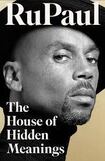
“What,” RuPaul wonders, “would it be like to be the prettiest girl of them all?” In House of Hidden Meanings, you can hear RuPaul – the towering black queen behind the television phenomenon Drag Race – pronounce every word. There are flashes of his “naughty-lite” alter ego, who he describes as “two spoonfuls of Diana Ross, a pinch of Cher, a shade of Dolly Parton, all sealed with Walt Disney’s friendliness”.
This is not RuPaul’s first autobiography. His 1995 Lettin’ It All Hang Out, was written in the wake of his hit song Supermodel (You Better Work). In it, it is the glamazon who recounts the story of the gay man who created her. In Hidden Meanings, it is RuPaul Andre Charles who tells the tale. On the cover of the book is a photograph of the author in non-drag and a goatee. The narrative is of a once-confused black boy who was able to evoke, within himself, a goddess. (For clarity I will use the pronouns he/him.)
Hidden Meanings is a heady encapsulation of a bygone era, of Atlanta public access television shows and sleazy Manhattan East Village bars. It is a journey through RuPaul’s triumphs and failures, and his battle with addiction. It presents a view of drag queen life, which requires queens to be comedians, musicians, and dancers while fitting themselves into wigs and corsets. To echo a quote about Ginger Rogers, they accomplish everything backwards, and in heels. It is a glimpse into RuPaul’s restless mind, one that connects Donna Summer and Blaxploitation star Pamela Grier to Tennessee Williams and François Truffaut. In Atlanta he remakes a Karen Black horror film with him playing Black and the monster as Thomas Gainsborough’s Blue Boy.
There is a long record of men dressing as women, including Indian hijra, Italian castrati and Shakespeare’s enchanting ladyboys. However, the first “drag queen” was black. William Dorsey Swann, a former slave, coined and anointed himself with the title. In the 1880s Swann hosted balls, where former slaves dressed like Southern plantation mistresses. At its conception, drag was black and rebellious, subverting the practices of its oppressors.
The Ghosts of Rome by Joseph O’Connor: Follow-up to My Father’s House draws an extraordinary picture of Rome under Nazi control
Documents on Irish Foreign Policy (Vol 14) 1969-73: The North, above all else, required the Department of Foreign Affairs to up its game
Fiction in translation: A glimpse of failed far-right coup leader’s assured gifts as a storyteller
Michael Longley funeral: Poets and politicians gather for writer who ‘touched the soul and imagination of many’
Swann does not make an appearance in RuPaul’s book, which skates through black and gay history. RuPaul condenses the darkness of 1980s New York with one sentence - “the heaviness of crack cocaine, the AIDS epidemic” - while spending paragraphs on when Madonna threw him shade. However, for those who are new to these horrific pasts, his words make a mark. “When you hear stereotypes of Black people who can’t swim or are afraid of dogs, it’s because for so many generations, they were afraid of swimming across bodies of water to flee, or afraid of dogs, because they were afraid of being chased.”
The most moving episode is when RuPaul fails in New York and runs back to his mother in San Diego
There is much self-help. “Become your own icon,” RuPaul crows. He is also fond of polarity, “black and white, yin and yang”. This gives way to sentences that seemingly shimmer, but make little sense. For instance, “The sun in San Diego had a silvery hue, hot in its directness but cool in the shade”. Despite the book’s title, there are no “hidden meanings”, because every anecdote has a moral. But many readers have already sipped the RuPaul Kool-Aid. Personally, I came of age in a New York that RuPaul had made friendly, dancing at East Village’s Pyramid, a woman of colour working in the bottom tier of Vogue. As a result, his descriptions made me smile.
RuPaul is best at his most precise. He recollects his mother taking to him to his first day of kindergarten in a “knock-off of a Dior silhouette ... cinched at the waist and then gathered out, with buttons down the front, a popped collar, and a three-quarter sleeve”. RuPaul is also fastidious about giving credit. What many consider to be a RuPaul mantra, “You’re born naked, and the rest is drag,” he attributes to a queen that a friend saw at a show. Most importantly, this memoir is honest. While flamboyantly unapologetic about being “model-esque”, he is upfront about his humiliations. The most moving episode is when RuPaul fails in New York and runs back to his mother in San Diego.
The book is structured as a classic quest. RuPaul writes, “[My mother] went to see a psychic, who told her that the baby she was carrying was a boy and that he was born to be famous.” Like many heroes, he flies too close to the sun. Like Zeus, he births a goddess from his brain. However, Hidden Meanings does not chart RuPaul’s ascension to Drag Race fame. Its most poignant passages are muted, like a picnic of peanut-butter cookies he shares with his sister. The final chapter is titled “Home”. Ultimately, this journey – while enlivened by RuPaul’s allure – is an odyssey dedicated to finding the place where he belongs.













